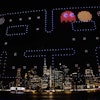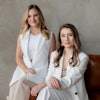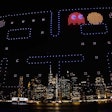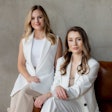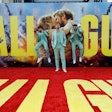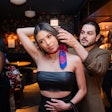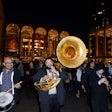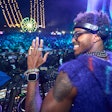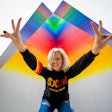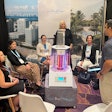The makeup counters were hubs of activity, with eager customers clamoring to buy everything from brushes to body paint. But this wasn’t the cosmetics department of a department store, it was the Makeup Show NYC, a small trade expo for the professional makeup artist community. And it wasn’t just about learning about (and buying) the latest products; it was also about education: hands-on workshops, seminars, and keynote speeches. Over two days, 3,000 attendees were expected to brush up on their makeup at the Metropolitan Pavilion.
Call the Makeup Show, created and produced by the Powder Group and Metropolitan Events and Production, the little trade show that could. Now in its third year, the show has grown in both size and scope. Originally launched in Manhattan, it is now produced in Miami as well. (The first Miami show was held in February; it will return next year). More locations—possibly Los Angeles, Las Vegas, and London—are in the works.This year’s New York show included six sponsors (up from four last year) and new exhibitors, including big-name cosmetics brands like Lancôme and Procter & Gamble’s Cover Girl and Max Factor.
“We had to move around the floor plan in order to accommodate [everyone],” said Shelly Taggar, director of sales and creative services for Metropolitan Events and Production. “We pushed our show partner into the lobby area and moved the registration to our outer lobby, which used to be non-used space.” To handle the early-morning crush of attendees, an extra staffer was on hand to help handle registration.
“The challenge was creating a whole new floor plan and making sure it works, and that the vendors don’t feel overwhelmed," Taggar said. “Vendors can’t explain anything if there are 60 people on top of them.”
To help with the traffic flow, Taggar made sure the show included a strong lineup of speakers on Sunday morning—the show’s busiest time—so the exhibit main floor wasn’t slammed with attendees. (Keynotes and workshops were held on the Pavilion’s fourth and fifth floors.)
But growing the show has presented challenges beyond logistics. “Part of the reason our exhibitors are happy is we handpick them; we’ll never have 20 [vendors] who sell brushes. That’s what’s going on in other trade shows,” Taggar said. “Being intimate is part of what makes us different, so we don’t want to grow too big.”
“This is an edited show on every level, from the vendors to the attendees,” said Michael DeVellis, executive producer of the Powder Group.
To that end, part of the thinking in expanding to other locations is to fill specific niches. The Miami show attracts vendors for beauty, body art, and tanning, Taggar said, while an L.A. show would focus more on special-effects makeup.
Call the Makeup Show, created and produced by the Powder Group and Metropolitan Events and Production, the little trade show that could. Now in its third year, the show has grown in both size and scope. Originally launched in Manhattan, it is now produced in Miami as well. (The first Miami show was held in February; it will return next year). More locations—possibly Los Angeles, Las Vegas, and London—are in the works.This year’s New York show included six sponsors (up from four last year) and new exhibitors, including big-name cosmetics brands like Lancôme and Procter & Gamble’s Cover Girl and Max Factor.
“We had to move around the floor plan in order to accommodate [everyone],” said Shelly Taggar, director of sales and creative services for Metropolitan Events and Production. “We pushed our show partner into the lobby area and moved the registration to our outer lobby, which used to be non-used space.” To handle the early-morning crush of attendees, an extra staffer was on hand to help handle registration.
“The challenge was creating a whole new floor plan and making sure it works, and that the vendors don’t feel overwhelmed," Taggar said. “Vendors can’t explain anything if there are 60 people on top of them.”
To help with the traffic flow, Taggar made sure the show included a strong lineup of speakers on Sunday morning—the show’s busiest time—so the exhibit main floor wasn’t slammed with attendees. (Keynotes and workshops were held on the Pavilion’s fourth and fifth floors.)
But growing the show has presented challenges beyond logistics. “Part of the reason our exhibitors are happy is we handpick them; we’ll never have 20 [vendors] who sell brushes. That’s what’s going on in other trade shows,” Taggar said. “Being intimate is part of what makes us different, so we don’t want to grow too big.”
“This is an edited show on every level, from the vendors to the attendees,” said Michael DeVellis, executive producer of the Powder Group.
To that end, part of the thinking in expanding to other locations is to fill specific niches. The Miami show attracts vendors for beauty, body art, and tanning, Taggar said, while an L.A. show would focus more on special-effects makeup.
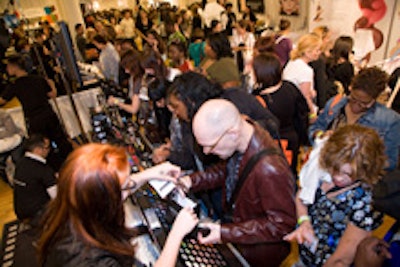
The Makeup Show's busy floor
Photo: Nadav Vee

The main floor of the Makeup Show comprises the north and south pavilion of the Metropolitan Pavilion.
Photo: Nadav Vee
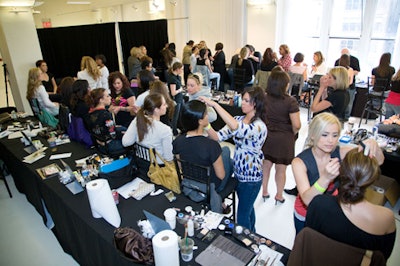
The trade show includes beauty workshops.
Photo: Nadav Vee
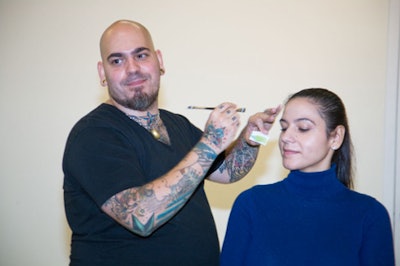
Makeup artist James Vincent was on hand at the show to demonstrate makeup application for high-definition television.
Photo: Nadav Vee


